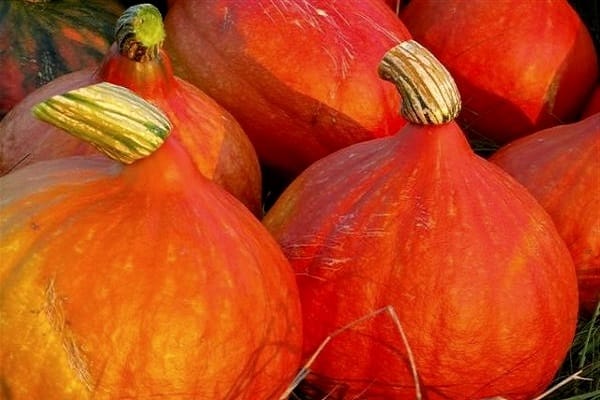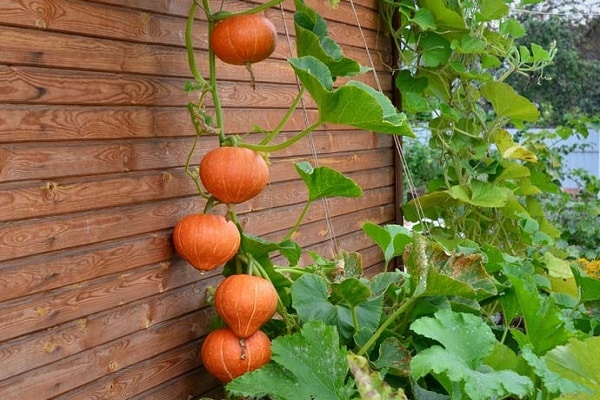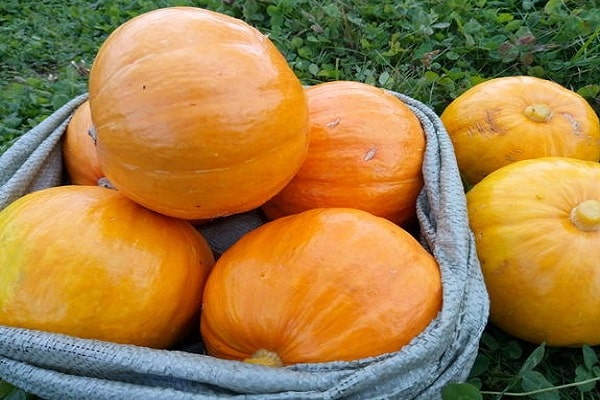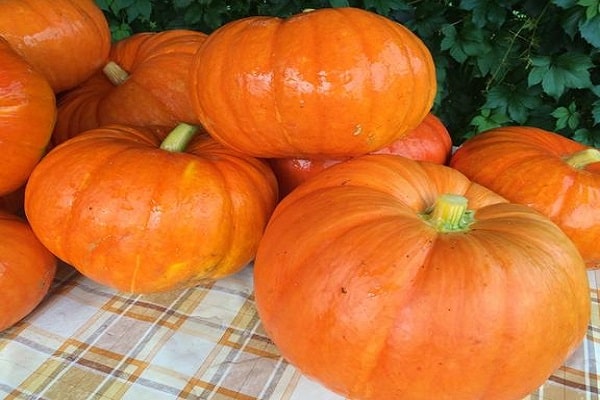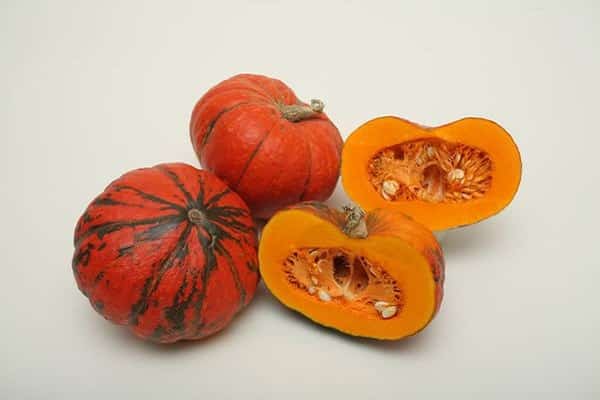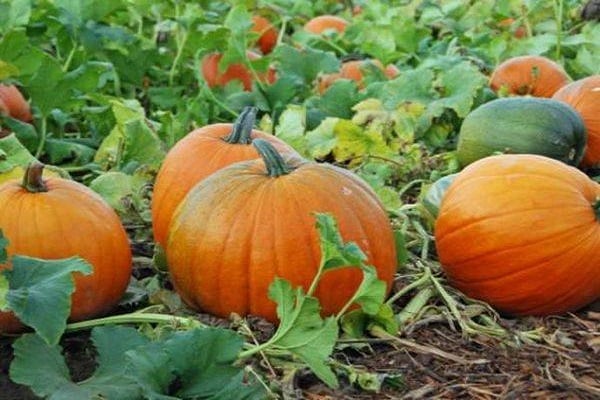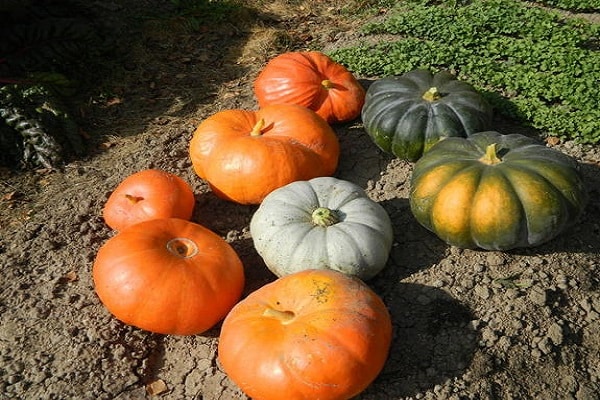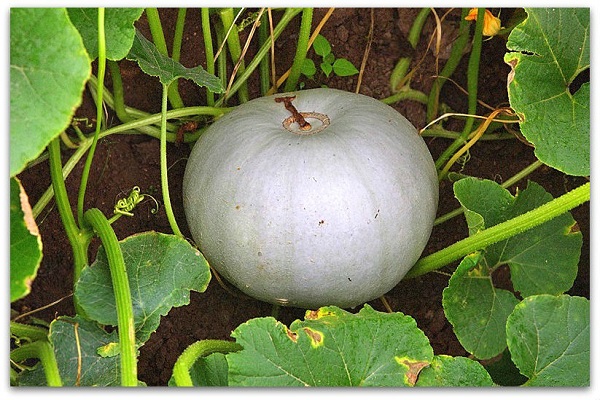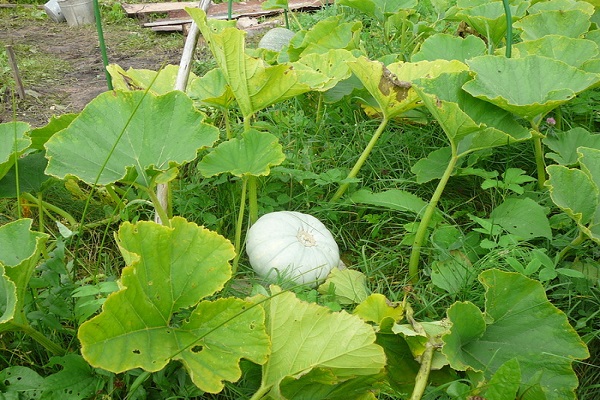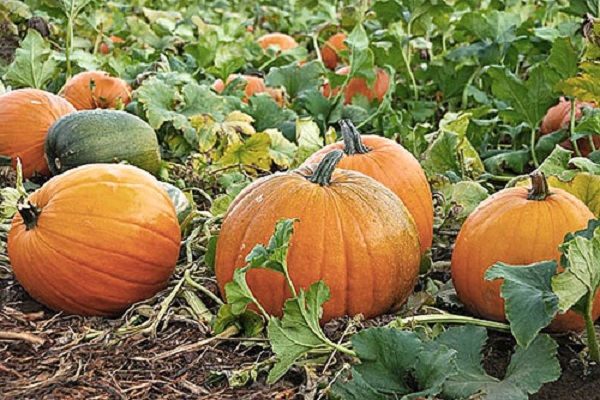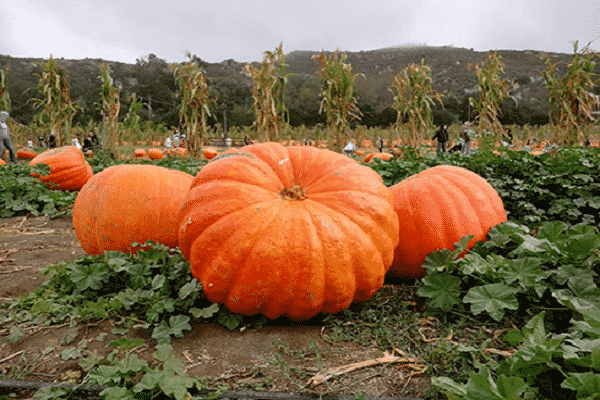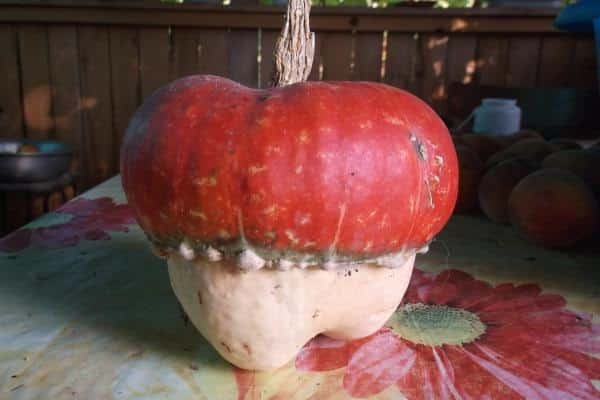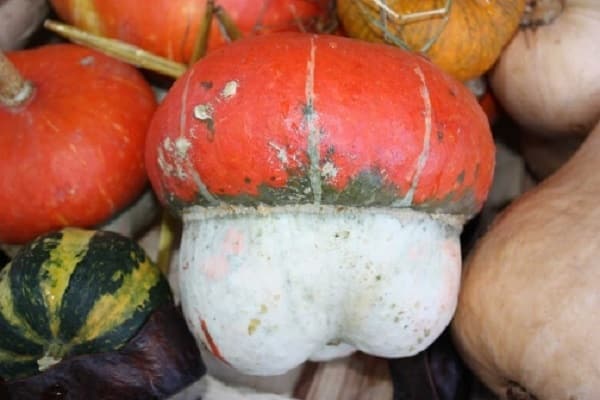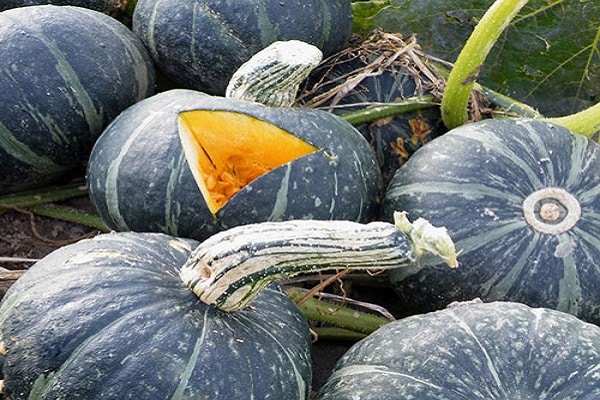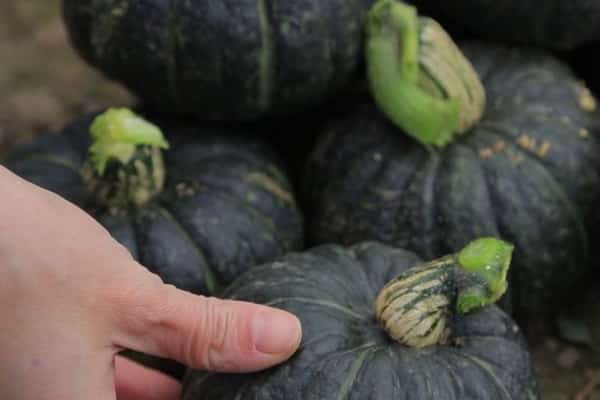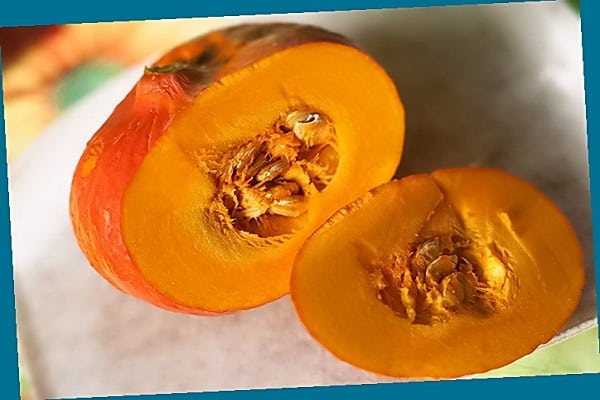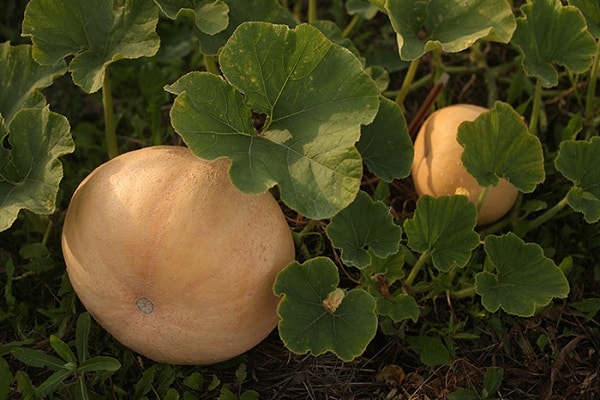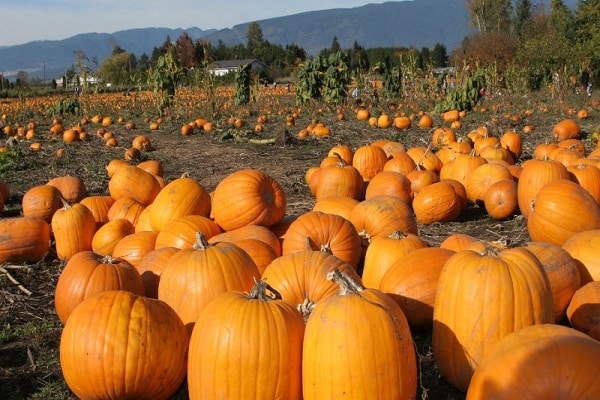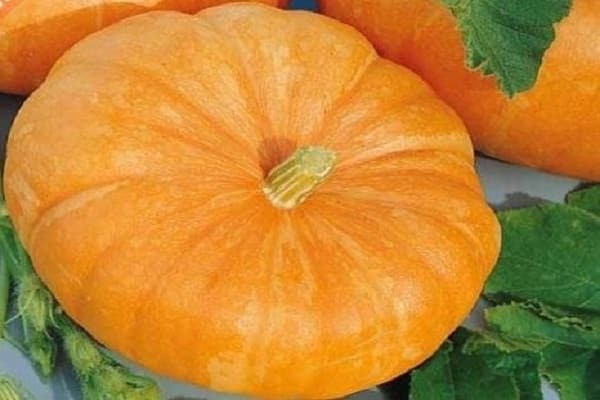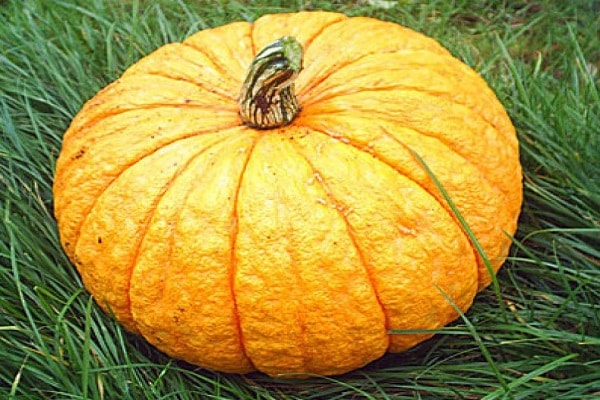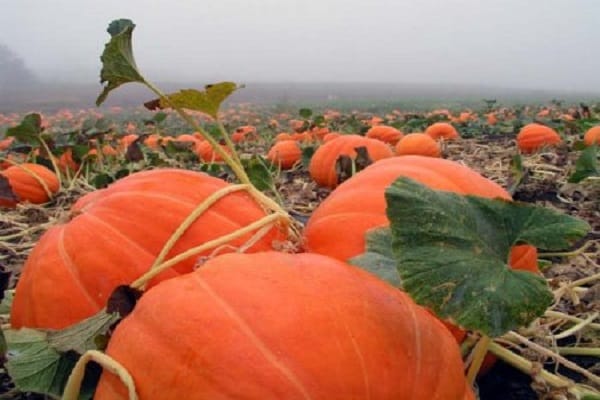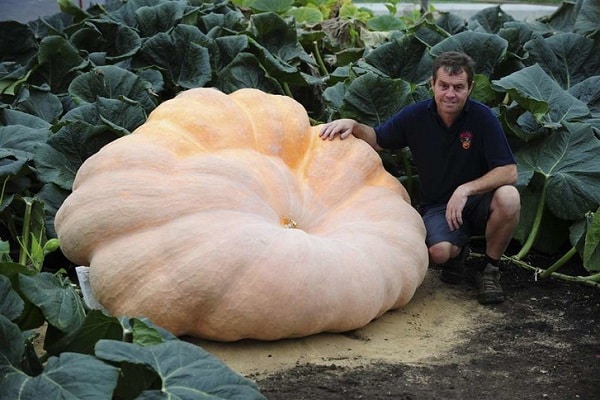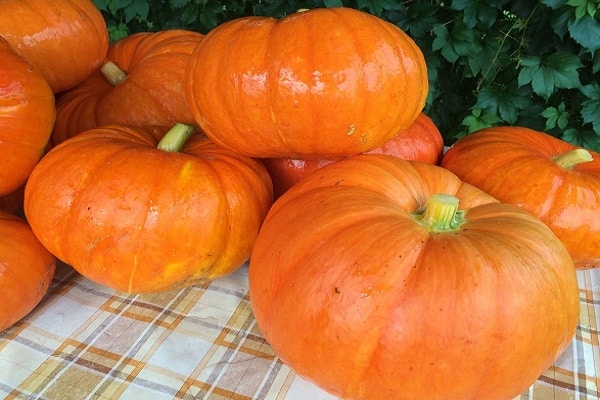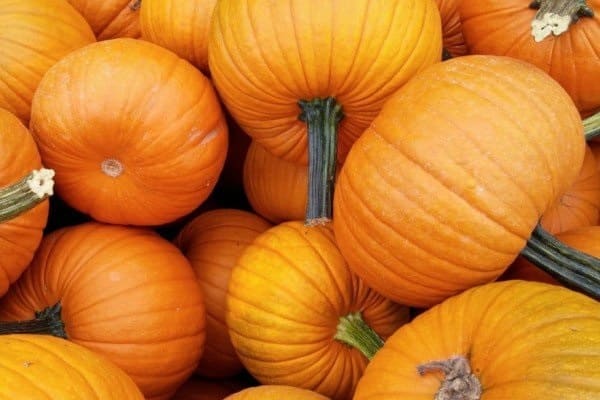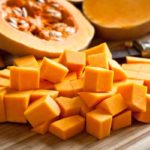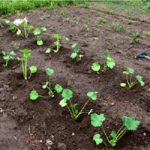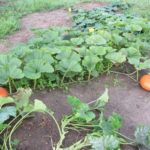Large-fruited pumpkin varieties are especially popular in our country because they grow well in the harsh conditions of the middle zone, are well stored and have an excellent sweet taste. The variety of species allows each gardener to choose the best option for the “orange beauty”.
Russian
Due to its unpretentiousness, the early ripening Russian pumpkin is an excellent choice for beginners and those who cannot devote a lot of time to growing and caring for it.
The description and characteristics of the variety are as follows:
- the fruit is similar in shape to a spinning top;
- its weight is from 2 to 4 kg;
- the pulp is bright, sweet, distinguished by a melon aroma, and can be up to 6 cm thick;
- The skin is dense and durable, thanks to which the pumpkin is stored until spring, retaining its beneficial and taste properties.
To grow Russian pumpkin, it is important to carry out proper planting, soil cultivation and care. You can plant pumpkin both by seeds and seedlings. The best soil is sandy loam and loam. Two days before planting, the beds are dug up and nitrogen-containing additives are added. At growing pumpkin seedlings It is advisable to use a special peat humus container, which is filled with soil consisting of turf soil and humus in the proportion: 4:1.
You can plant Rossiyanka in the ground in mid-to-late May, when the soil temperature rises above 12 °C. The bush turns out to be compact, so it will not need much space: the optimal distance between plants is 60 cm. The holes 5 cm deep are pre-moistened.
Further actions boil down to timely weeding, loosening, and fertilizing. Forming pumpkin lashes performed by pinching the main and additional stems. However, this type of pumpkin vegetable is so unpretentious that it can produce a good harvest even without care.
Sweetie
The fruits of the mid-season variety Konfetki are loved by gardeners for their exquisite sweet taste and the fact that long-term storage does not harm them at all, but, on the contrary, makes them even softer, sweeter and tasty.
The pumpkin description includes the following benefits:
- High yield.
- Unpretentiousness.
- Excellent taste.
- High percentage of carotene and vitamin C.
Candy pumpkin can be used to prepare first and second courses, or add raw to salads.Juices made from fruits are especially useful; they contain large amounts of pectin, which has a beneficial effect on the gastrointestinal tract.
To plant this pumpkin, you will need a spacious area illuminated by the sun, since the lashes it produces can reach 2 meters. The best soil for Candy are light and medium loamy soils. Before planting, the ground should be dug up and manure or rotted compost should be added to it (per 1 m2 contribute 7 kg).
In warm regions, Candy is planted with seeds, in cold regions - with seedlings.
When growing pumpkin seeds, follow these steps:
- Check the seeds for germination by wrapping them in a damp cloth for a day.
- Disinfect by placing in a weak solution of potassium permanganate.
- Perform hardening: soak in heated water and leave in the refrigerator for 3-4 days.
For planting, you need holes 8 cm deep: the distance between adjacent holes is at least 90 cm. Each one must be moistened and 3-4 seeds placed in it. When sprouts appear, you should leave only one, the strongest one.
For growing seedlings and ease of subsequent care, you can use any container 8 cm deep. It is filled with turf soil with the addition of peat and humus, the seeds are planted in holes 5 cm deep and the container is placed in a cool, well-lit place. After 2 weeks, the pumpkin sprouts should be carefully tilted and covered with soil. A few days before planting, the seedlings are taken outside every day for several hours for the purpose of hardening.
Feeding, watering and loosening are carried out no earlier than 10 days after planting. The best fertilizer for this variety of pumpkin is a solution of chicken manure (1 part to 20 parts water). As for mineral supplements, Sweetie loves ammonium nitrate.Sprinkling the lashes with earth allows you to strengthen the root system.
With proper care, each vine usually bears from 6 to 8 fruits, which, when ripe, reach an average weight of 3 kg. If you want to get larger fruits, pinch the main stem of the pumpkin (after 3-4 ovaries).
Chit
Pumpkin Kroshka is a mid-season variety with a vegetative period of 115–125 days.
The following characteristics are most often given in seed descriptions:
- the fruits weigh only 1–2 kg;
- have a round, slightly flattened shape;
- its skin is almost white, greenish and dense;
- The pulp is bright orange, sweet, slightly juicy, with a pleasant nutty aroma.
Pumpkin seeds, whose taste resembles a nut, are highly valued.
To grow an excellent harvest, Kroshka should be planted in May, in a greenhouse, for which pre-soaked pumpkin seeds are buried in the soil with the blunt tip down. After the first two leaves appear, the plant can be transplanted into moist open ground.
If there is a possibility of frost, the seedlings are protected from above with caps made from plastic 5-liter bottles with the bottom cut off.
When Baby grows up, the bottles can be removed and the soil around the plants can be covered with grass. After 2 or 3 ovaries appear, the lashes should be pinned. These plants are distinguished by the fact that they do not require special care: weeding, watering, and fertilizing with organic fertilizers will make it possible to reap a decent harvest in the fall.
hundred pound
The hundred-pound pumpkin belongs to the mid-late varieties; its fruits are spherical in shape with a smooth surface and have a weakly segmented structure, varying from 10 to 50 kg. The skin is thin, yellow-orange, the flesh is cream-colored, loose, and slightly sweet.
One hundred pound pumpkin contains pectin, a whole complex of vitamins, valuable organic acids and minerals, and can be consumed fresh, in the form of juices or in processed form.
Pumpkin can be planted as seeds in soil heated to 12 °C (in April-May), or as seedlings, transplanted into open ground after a month. Open, unshaded areas with super sandy or light loamy soil are ideal for hundred pound.
The plant forms lashes of medium length, so there should be at least 80 cm between the nearest holes when planting. The depth of the holes is 5–10 cm.
According to the description, the variety is not afraid of powdery mildew and bacteriosis, is not susceptible to rot, but in cold areas it does not have time to ripen, so it is grown mainly in the southern regions. Caring for plants comes down to regular watering, weeding, loosening, fertilizing; the harvest is harvested from late August to mid-September.
Little Red Riding Hood
The ripe fruits of the Little Red Riding Hood pumpkin or turban pumpkin look like a mushroom with a red cap. Their weight can vary from 300 grams to 4 kg.
Among the advantages of the vegetable and what affects the favorable reasons for seed germination is the following:
- Early ripening: the vegetative period is about 100 days.
- High yield: one bush can produce 20 fruits.
- Cold resistance.
- Drought resistance.
- Immunity to powdery mildew.
But the main advantage that captivates many gardeners is the amazing taste of the bright orange pumpkin pulp: tender, crumbly, with a light melon aroma and devoid of the astringency characteristic of other large-fruited varieties. This variety is also attractive for its ability to ripen during storage, becoming sweeter and tastier by mid-winter.
Little Red Riding Hood can be grown by seeds (planting in May-June) or seedlings (planting in April-May).The vines of this plant are quite long (up to 3 meters), but if you create a support for it, the bush will grow upward and will not take up much space.
Planting pumpkins in open ground should be done by choosing a sufficiently lit area, avoiding places where pumpkins of other varieties or their “close relatives” such as cucumbers and zucchini previously grew. Neighborhood with other representatives of large-fruited pumpkins is also undesirable.
Sweet chestnut
The fruits of the Sweet chestnut pumpkin are small, weigh about 600 g, have the shape of a flattened ball, and have weak segmentation. The skin is thin, dark green with lighter spots. The pulp is bright, dense, starchy and sweet, tastes like an edible chestnut, and is crumbly when baked.
Sweet chestnut is sensitive to cold, so in the middle zone it is better to grow pumpkin as seedlings. Pumpkin seeds are sown for seedlings in early May, at 20–30 °C and good light, the first shoots appear within a week. In the absence of frosts, you can transplant into open ground already in mid-May.
Planting with seeds, which is carried out at the end of May, mid-June, is possible in regions with a warmer climate. Seeds are planted in a well-lit area with fertile, carefully prepared soil; there should be at least 70 cm between adjacent plants, and the distance between adjacent beds should be 1 m. Planting depth - 8–10 cm.
Sweet chestnut is undemanding to care: regular watering and weeding will help increase productivity at home. Harvest occurs at the end of August - beginning of September. The fruits can be stored until early spring.
Baby
Baby is one of the early ripening pumpkin varieties: only 3 months pass from the appearance of the first sprouts to the full ripening of the fruits.Female flowers are formed as early as 30–40 days, so the plant should be protected from frost by covering it with plastic caps.
Baby pumpkin is classified as a bush variety, which forms a compact bush with medium-length vines. The fruits are slightly flattened, segmented, located at the base of the stem, their weight does not exceed 4 kg, the skin is dark gray with brown spots, rough. The pulp is medium dense, crispy, sweet, tasty, and has a high percentage of sugar and carotene.
In the middle zone, Malyshka is grown mainly in the standard way - seedlings. Sowing is carried out in April; seedlings need well-fertilized, moist soil with a temperature of 25–30 °C. Transplantation into the ground - in May-June, plants are planted no closer than 60 cm from each other, the gaps between adjacent rows are 1 m. The holes are pre-moistened.
With timely weeding, watering and the application of organic fertilizers, the Malyshka pumpkin variety is capable of producing a good harvest (3.2 kg/m2) by the end of summer, beginning of autumn.
Paris gold
This type of pumpkin does not require frequent, abundant watering and mulching, but loves warmth, so it will be the best option for residents of hot, arid regions.
The Parisian gold variety has the following characteristics:
- fruits are bright golden in color, in the shape of a flattened ball and with weak segmentation;
- the weight of a ripe pumpkin is from 4 to 10 kg, but when planted on fertile soils it reaches 16 kg;
- the skin is thick, lumpy, the flesh is bright orange, tasty, juicy, making this variety ideal for juices, soups and baby food.
Parisian gold can be stored for a year without losing its taste.The variety is an early ripening variety, loves sandy and loamy soils, as well as sunny and warm areas. It can be planted by seeds, but to increase productivity it is better to grow seedlings. Sowing of seedlings is carried out in May; transplanting into open ground is possible after the ground has warmed up to a temperature of 10–12 °C. The ideal place for growth is the middle zone.
When planting seeds (May-June), they are buried 1.5 cm into the soil, 2 grains are placed in each hole, and when shoots appear, the weaker sprout is removed. The distance between the holes is at least 60 cm.
You can increase the yield of Parisian golden pumpkin by:
- Pinching the main stem and side shoots after several ovaries appear on them.
- Timely watering, loosening, weeding.
- Fertilizing with organic fertilizers (chicken manure).
- Mulching the soil with peat or dry humus.
- Hilling up plants with damp soil (to strengthen the root system).
The vegetative period is approximately 100 days, fruit harvesting occurs in August-September.
Titanium
Titan is the best solution for gardeners who want to grow pumpkins of record sizes on their plot: the average weight of a ripe pumpkin is about 50 kg, maximum - 500 kg! The fruits can be flattened, absolutely round, or elongated, have a bright orange color and clear segmentation. The pulp is sweet and juicy.
The pumpkin variety Titan is a mid-season variety. It ripens within 4 months and requires space because it forms powerful and long vines up to 7 meters in length: it is recommended to place each plant in a square with a side of 1 m.In addition, it will need a sufficient amount of light, moderate soil moisture, fertile soil fertilized with humus and an average temperature of 15 ° C.
It should be remembered that Titan does not like acidic, damp clay soils, does not tolerate excessive watering, and should not be planted close to representatives of related crops.
In the middle zone, this variety is grown as seedlings; planting is carried out in May, for which peat cups are used. After planting in the ground, the sprouts of each plant should be protected from frost, wind and heavy rain using small barriers.
Zorka
It is considered the most delicious of large-fruited pumpkins, it has a record amount of sugar, and its pulp contains more carotene than carrots - for this reason, Zorka is often used in baby and medical nutrition.
The fruits of the Zorka pumpkin variety are round in shape, the skin is thin, dark green, sometimes with a gray coating, smooth, with yellow longitudinal stripes, the segmentation is weakly expressed. Zorka's weight can be 7 kg. The pulp is juicy, bright orange, dense, sweet, an ideal filling for pies and suitable for canning.
This pumpkin is a mid-early pumpkin; the period from germination to harvest is 110 days. The vegetable prefers sandy and loamy soils, loves warm, moderately moist, sunny areas. Zorka pumpkin should be sown no earlier than the end of May, when the soil warms up to 12 °C. It is also possible to grow seedlings.
After the harvest is harvested, it is necessary to ensure timely storage.
Sweet pie
The advantages of the pumpkin variety include stable, fairly high yield.Sowing of seeds is carried out in May-June, seedlings can be grown from mid-April, after 20 days they are transplanted into the ground. The distance between plants is 70 cm, the depth of the holes is 6 cm.
The description of the Sweet Pie pumpkin variety is as follows:
- pumpkin fruits reach a weight of 2–3 kg, have a round, slightly flattened shape with well-defined segmentation;
- the skin is smooth, bright orange;
- the pulp is juicy, crispy, sweet.
There are at least a dozen more large-fruited varieties. When choosing them, you should take into account the characteristics of the region and the possibilities for caring for the plant, and then the beautiful pumpkin will certainly delight you with a bountiful harvest.

